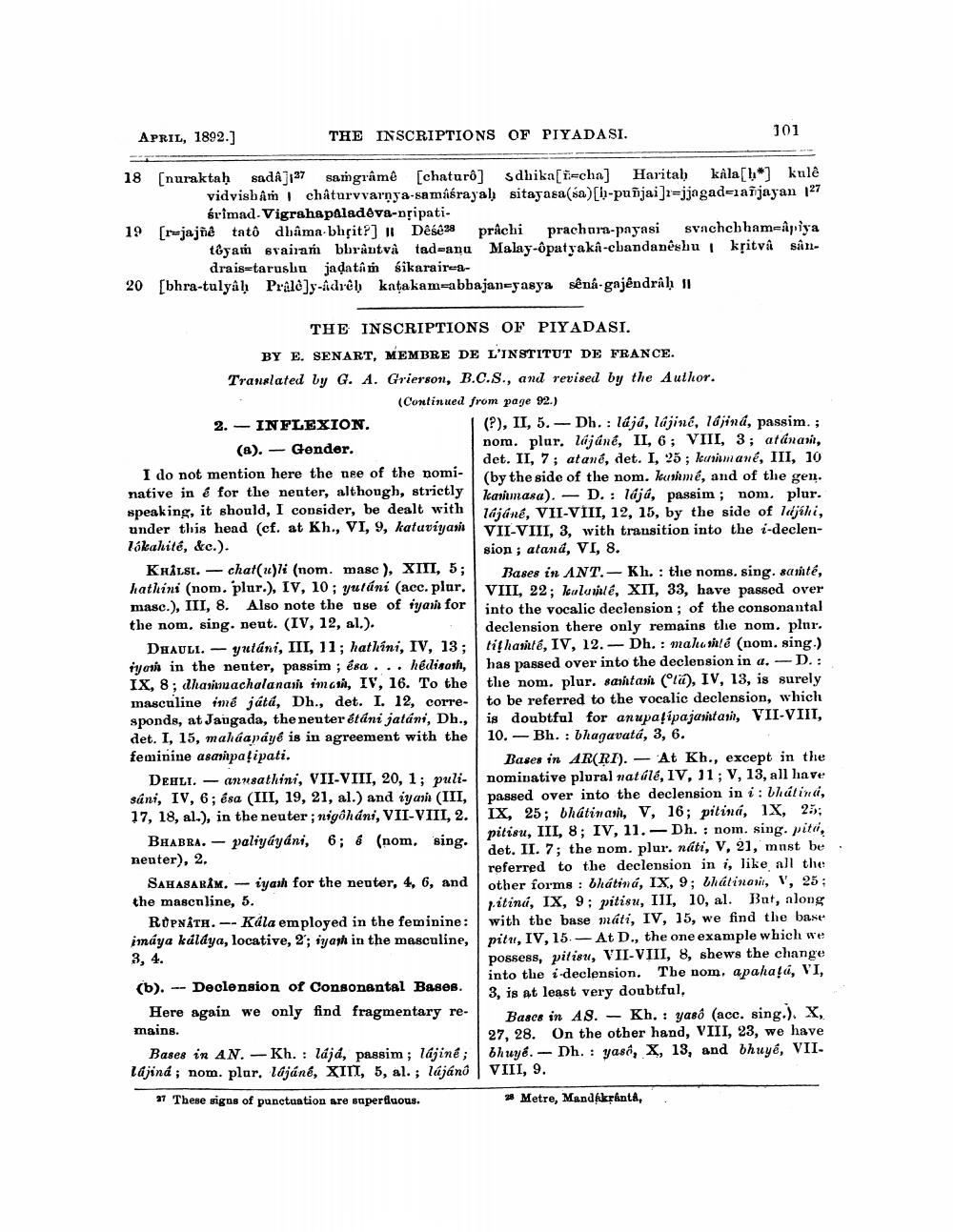________________
APRIL, 1892.)
THE INSCRIPTIONS OF PIYADASI.
101
18 (nuraktaḥ sada] 27 samgrâmê [chaturô] Sdhika[i=cha] Haritah kala[1] kulê
vidvish Âm châturvvarnya-samasrayal sitayasa (sa)[h-punjai]2=jjagad=laijayan 127
srimad. Vigrahapaladeva-nipati19 [ræjajñé tato dhama-bhçit?] | Dése28 prachi prachora-payasi svachchhamrapiya
tậyam svairan bbrântvà tad-anu Malay-ôpatyaka-cbandaneshu kļitvå sân
drais-tarushu jadatim sikarair-a20 [bhra-tulyâh Pral@]y-adreh katakam-abbajaneyasya sêná-gajêndrâh I
THE INSCRIPTIONS OF PIYADASI. BY E. SENART, MEMBRE DE L'INSTITUT DE FRANCE. Translated by G. A. Grierson, B.C.S., and revised by the Author.
(Continued from page 92.) 2.- INFLEXION.
| (?), II, 5. - Dh. : lájá, lájiné, lajiná, passim.;
nom. plur. lájánė, II, 6; VIII, 3; atánari, (&). - Gender.
det. II, 7; atané, det. I, 25; kuimané, III, 10 I do not mention here the nee of the nomi
(by the side of the nom. kurimé, and of the gen. native in é for the neuter, although, strictly
kariumasa). - D. : lájú, passim ; nom. plur. speaking, it should, I consider, be dealt with
lájáné, VII-VIII, 12, 15, by the side of lajini, under this head (cf. at Kh., VI, 9, katuviyasi
| VII-VIII, 3, with transition into the i-declenlákahité, &c.).
sion ; atand, VI, 8. Khils. — chat(u)7i (nom. mase ), XIII, 5; Bases in ANT. - Kh. : the noms. sing. sarité, hathini (nom. plur.), IV, 10; yuláni (acc. plur. VIII, 22; kuluvilé, XII, 33, have passed over masc.), III, 8. Also note the use of iyari for into the vocalic declension; of the consonantal the nom. sing. neut. (IV, 12, al.).
declension there only remains the nom. plur. DHAULI. - yutáni, III, 11; hathini, IV, 13; tithasilé, IV, 12. - Dh. : malonial é (nom. sing.) iyoria in the nenter, passim ; ésa ... hedisah, has passed over into the declension in a. - D.: IX, 8; dhaimachalanasi imta, IV, 16. To the the nom. plur. saritasi (), IV, 13, is surely masculine imé játá, Dh., det. I. 12, corre- to be referred to the vocalic declension, which sponds, at Jangada, the neuter étáni jatáni, Dh., is doubtful for anupalipajaritan, VII-VIII, det. I, 15, maháapayé is in agreement with the 10.- Bh. : bhagavatá, 3, 6. feminine asanpaļipati.
Bases in AR(RI). - At Kh., except in the De Ll. - annsathini, VII-VIII, 20, 1; puli- nominative plural natale, IV, 11; V, 13, all have sáni, IV, 6; ésa (III, 19, 21, al.) and iyani (III, passed over into the declension in i: lhátindi, 17, 18, al.), in the neuter; nigoháni, VII-VIII, 2. IX, 25; bhátinasit, V, 16; pitina, IX, 255; BHABRA. - paliyáyáni,
pitisu, III, 8; IV, 11.-Dh. : nom. sing. pitii, 6; & (nom. sing.
det. II. 7; the nom. plur. náti, V, 21, must be neuter), 2.
referred to the declension in i, like all the SAHABARİM. -iyash for the neuter, 4, 6, and other forms : bhátiná, IX, 9; Whátinorit, V, 25: the mascnline, 5.
pitinu, IX, 9; pitisu, III, 10, al. But, along ROPnÂTh. -- Kála employed in the feminine: with the base máti, IV, 15, we find the base imáya kulaya, locative, 2; iyan in the masculine, pitu, IV, 15. - At D., the one example which we 3, 4.
possess, pitisu, VII-VIII, 8, shews the change
into the i declension. The nom, apahaļa, VI, (b). -- Declension of Consonantal Bases.
3, is at least very doubtful, Here again we only find fragmentary re- Basce in AS. – Kh. : yasố (acc. sing.). X, mains.
27, 28. On the other hand, VIII, 23, we have Bases in AN. -Kh. : lấja, passim; lajime; | Bhuyề. - Dh. : yasa, X, 18, and bhuyế, VII. lajiná ; nom. plur. lájáné, XIN, 5, al.; lájánó | VIII, 9.
97 These signs of punctuation are superfluous.
* Metre, Mandkkrenta,




